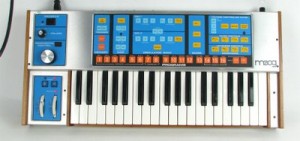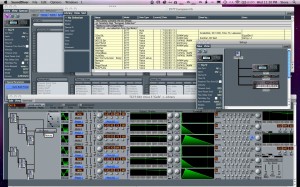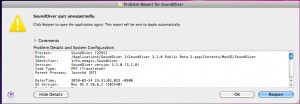Read part one here.
When I was thirteen or so I read the novelization of Close Encounters (because it was lying around the house and I was thirteen and bored, smartass). The chapter in which the big-ass modular synthesizer appeared opened with a statement somewhere along the lines of “There are few people in the world who can afford a Moog modular synthesizer, and even fewer who know how to program one.” That’s an odd thing to say for a couple of reasons. Firstly, the synth in the movie was actually an ARP 2500, not a Moog. But secondly, as much as it serves the drama of the setting to deny it, and as easy as it is to be overwhelmed by all the cables and dials and switches, an analogue synthesizer is not really all that difficult to wrap your head around. I could teach you how to patch a modular synth in a couple of hours. It would take a little more experience for you to be able to sit down at one and duplicate a sound you heard on an album, but the principles, and the components and variables involved, are pretty straightforward.
I don’t know why they needed an ARP 2500 (or the big monochrome light organ) to play that five-note message from the aliens. By 1977 there were quite a few synths that could have done the job just as well with a lot fewer cables. Of course, it wouldn’t have looked quite as cool if that scene was done on a Minimoog, but with the right amplification it would have sounded pretty much the same. And Moog had been making those since 1970.
In the pre-digital days, manufacturers had to compromise flexibility for usability; they had to reduce complexity in order to make their instruments easier to program. Synths like the Minimoog or Prophet-5 contain circuitry which is representative of all the individual components you might find in a typical modular system from the 70s, assembled into a configuration that would be more practical for performers and recording artists. In a live situation, or in a studio when you’re paying by the hour, you want to be able to access your program parameters quickly and easily. These instruments allowed you to have all the controls that you need at your fingertips, but you lost the ability to run your LFO through the lag processor. Which, for most situations, was not a huge sacrifice.
Then digital comes along, and everything changes (okay, yes, the Prophet-5 had a lot of digital circuitry already, but let’s not confuse the general interest students) – manufacturers decided that if you could have a display screen that could tell you what parameter you’re adjusting, you could have just one big knob (I heard that, you in the back row) that could control all your parameters. You don’t have to have all those troublesome, confusing potentiometers cluttering up your front panel. You can then fill it with buttons that will recall all the different sounds that are now stored in digital memory. And then you end up with the Moog Source, which I think is probably the least desirable instrument ever created by Moog (in 1981, without the participation of Robert Moog, who had left the company several years earlier).
The next generation of synthesizers had a comparatively mind-boggling number of patch parameters with almost no real-time access. The Yamaha DX7, the most popular synthesizer ever released, has hundreds – possibly thousands, I never counted – of individual parameters per sound, and yet the front panel consists of 32 patch recall buttons, three sliders and a two-line LCD. But no one really cared because you pretty much needed an engineering degree to program one anyway.
This approach obviously creates a usability problem for people who want real-time access to those parameters, and after a few years of membrane switches and alpha dials, manufacturers realized that they were neglecting the needs of a significant customer base. The Roland JD-800 is a great example of a digital synth with a fully tweakable analogue-style interface, and it was very popular among those who could afford it. But once digital freed instrument designers from the fairly simple building blocks of analogue synthesis, samplers, ROMplers, FM and wavetable synths all became essential tools in the synthesist’s arsenal, and it was no longer practical to consider putting dedicated knobs and switches on the front panel of a synth. (Yes I know who Dave Smith is, pipe down, you.)
The advent of digital synthesis did not, however, magically eliminate the desire in performers, composers and enthusiasts to create and modify their own sounds. It just made the editing process a bit more of a pain in the ass. Fortunately, the digital synthesizer revolution was propelled by the same wave of technological advancement that was making the home computer a reality for the technologically-inclined consumer. And if you were interested in delving into the mysteries of FM synthesis, and if you had an Atari and a MIDI interface, you could design your own sounds, or modify the ones you bought from the music store, on that tiny little black and white screen – which, primitive though it may look now, was quite an improvement over that tiny LCD on the synth. All you needed was a DX7 Editor/Librarian. Create and modify your sounds with the editor, and then store them by the thousands (the original DX7 could only hold 32 patches in memory at a time unless you had the optional cartridge) and organize them with the librarian.
Then one day it occurred to some clever programmer (I assume he had more than one digital synth of his own) who decided that it was foolish to have a bunch of different applications, each of which did the same thing – exchange MIDI messages with synths and display sliders and envelope generators onscreen – for a different synth. I’m not sure what the first software to do this was. The makers of Midi Quest only claim that it is “the oldest actively supported software dedicated to getting the most from your MIDI hardware,” but I can’t find any hard dates claiming anyone else got there first. There was also Dr. T’s XoR, which evolved into MOTU’s Unisyn, which is also still available.
My universal editor of choice was called SoundDiver, and was made by Emagic, the same guys who made Notator for the Atari under the name C-Lab. You were wondering where this would all come together, weren’t you? I spent countless hours sorting, categorizing, and editing sounds on a number of synths – though mostly on my Kurzweil K2000, which was the most versatile and complex of the bunch – in SoundDiver. And when you collect synths, and work at music stores, and convert DX7 patches to TG77 format, and assemble keymaps from samplesets you download from the internet, for a few years, you end up with a lot of sounds. And once you have a lot of sounds, you have to sort through them and decide which ones you want to use. And you will add keywords to your library. And you will go in and tweak them, and re-save your tweaked sounds with new names so that your originals remain untouched. And you will keep track of which multi setups and combinations use which “children.” And if you have one program that allows you to do all this in one editing and cataloguing environment, you will be the master of your domain, as I was, for a time.
And then something interesting happened. Apple bought eMagic in 2002. We all thought this was pretty good news. The developers who made all that great software get to work for Apple, and probably got some decent coin out of the deal, and as a Mac user who was already using Logic I’m happy because it means my favourite audio software is going to be supported by the guys who make the hardware and operating system I’m running it on. It wasn’t such great news for Windows users however, as support for Windows versions of Emagic products was abruptly and unceremoniously dropped.
If that made users of SoundDiver on the Mac platform feel a bit smug, that feeling would fade gradually over the next year or two. As a hardware manufacturer, Apple had little incentive to support other manufacturers’ instruments. Logic already contained a number of virtual instruments when Apple acquired Emagic, and these instruments required a significant amount of processing power. Simply put, you can run your hardware synths off an Atari 1040. But if you want to play the latest and greatest softsynths, samplers and emulators included in Logic Pro 7 (released in 2004) you needed to buy a shiny new Mac. SoundDiver was quietly throttled, and all that remains of it is an OS X public beta which you still need the otherwise obsolete USB dongle to operate. But as development also ceased on the adaptions – the modules that contain the communication protocols for your hardware – even if you can get the public beta up and running on your Mac (and I can) you won’t be able to use it on any synth manufactured after 2003.
Is there a moral to this long and heartbreaking story? Sic transit gloria mundi, I suppose. But when the glory of hardware fades, at least you’re still left with the hardware. I’ve got about a billion TG77 patches on Atari floppies, none of which I expect to hear again. I’ve also got a fully-functional 30-year-old Prophet-5 in an Anvil case in the basement, and I sometimes think the money I’ve spent on now-obsolete software could have bought me another one.






You frighten me. Mostly in a good way…
I’d been looking for an opportunity to use the phrase “sic transit gloria mundi” which is latin for “gloria threw up on the bus on monday”